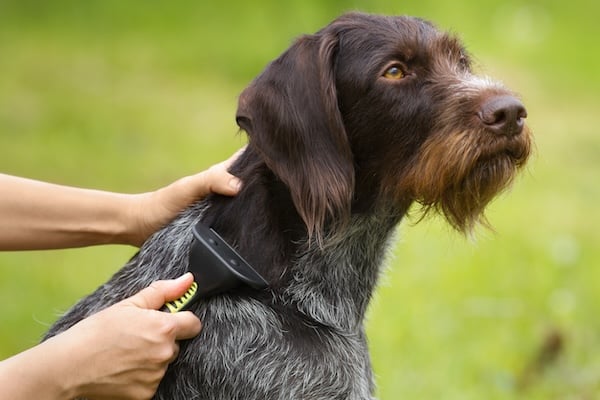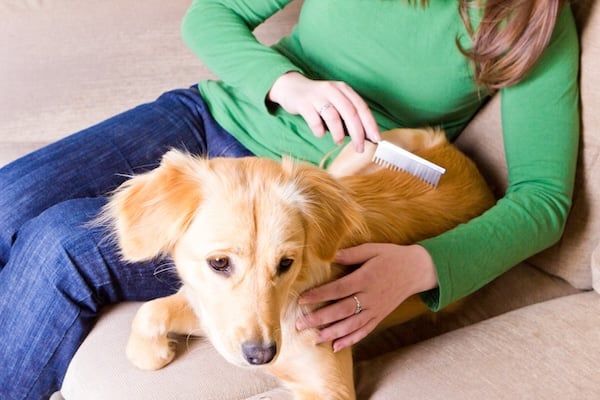Different types of dogs come with many different coat varieties and grooming needs. One thing is pretty universal, however: most dogs can benefit from brushing. But how to brush a dog, how often, and with which tools varies a lot between them.
We asked a couple of experts—certified fear-free dog groomers Sarah Cazares and Jules Cloud—to talk to us about basics of brushing your dog. That includes why it matters, how to brush a dog, and what different coats require, from long-haired to double-coated to curly and more.
How Often Should You Brush Your Dog?
Brushing is important across coat types, agree both groomers. “Brushing not only helps prevent mats and remove dead hair, but also massages the skin and spreads the natural, healthy oils on their skin. This oil, called sebum, is extremely important for preventing dry hair, dry skin, inflammation, bacterial issues, and even pests,” explains Cazares. “It can also be a valuable way to bond with your dog.”
| Coat type | Frequency |
| Slick-haired | Weekly, as needed, and more often during shedding seasons |
| Short-haired | Weekly, as needed, and more often during shedding seasons |
| Double-coated | Two to three times weekly, depending on hair length, and more often during shedding seasons |
| Non-shedding | Weekly to daily, depending on hair length |
| Wire coats | Hand-stripping on a breed-based schedule, as well as weekly brushing |
Slick or smooth-haired (Vizsla type). Slick-haired dogs don’t need much brushing, but a regular weekly brush can help redistribute oils. They may need more frequent brushing during shedding seasons. “If you’re seeing a lot of dander on your dog or clumps of hair forming, you may need to do some more frequent brushing,” explains Cloud.
Short-haired (Jack Russell Terrier type). Short-haired dogs can still be powerful shedders, but they don’t usually need to worry about mats. A dog with a short single coat can typically get away with a weekly brush for skin and coat health, plus more during shedding season. “A rubber curry brush is a great and non-abrasive brush option for this coat type,” Cloud advises.
If your short-haired dog has a double coat, like a Shiba Inu, consider increasing the frequency to two or three times per week, and daily during shedding seasons.
Double-coated (Labrador Retriever and Golden Retriever type). Double-coated dogs have two layers of fur: a thick undercoat and a longer topcoat. To keep both healthy, brush a double-coated dog twice a week, and more during shedding seasons. Longer double coats may need more frequent brushing to prevent mats.
Non-shedding coats (Doodles with a straight, wavy, or curly coat). How often you need to brush a non-shedding coat depends on how long the hair is. “Since these dogs typically get haircuts every four to six weeks, your frequency of brushing goes up the longer the coat is,” says Cloud. “A coat that is left one inch long all over will require daily brushing and combing. A dog who is shaved down with a ‘seven’ blade every six weeks may not have enough hair to brush between haircuts. Hair length, coat quality, and level of activity are the variables that will determine how much brushing you need to do.”
Wire coats. Wire coats typically need weekly brushing. But they also require less frequent maintenance using a technique called hand-stripping. Hand-stripping means methodically raking hands through your dog’s fur to pull the old wiry hairs out so the soft new growth can come in. It keeps the quality of the coat coarse and wiry.
How often your dog’s coat needs to be hand-stripped typically depends on the breed and can range from weekly to once every six months. The goal is to prevent too much hair from accumulating since that can make stripping painful. Your vet or groomer can help you determine the best schedule for your particular pup.

PavelRodimov via iStock
How To Brush a Dog
Regardless of coat type, always brush in the direction of hair growth, from bottom to top, says Cazares. This means starting at the legs and working your way up towards the head. “Brushing top-to-bottom can clump knots together and make them harder to get out. It can also make brushing more painful or uncomfortable by brushing many knots at once instead of a couple at a time.”
Make sure your brush reaches all the way down to the skin—but avoid applying so much pressure that you irritate the skin.
For long-haired breeds, practice line brushing. That means parting your dog’s hair in order to brush out tangles in lower sections first, typically with a slicker brush or comb. Once that’s done, you can add additional layers. A good dog-safe detangling spray will help you tackle any difficult spots.
What brushes to use
The best dog brushes for most grooming needs are rubber curry combs. Cazares explains: “It’s fantastic for short-to-medium hair dogs and cats alike. The rubbery material makes it gentle on the skin while also gripping onto the loose hairs. As an added bonus, it works great in the bath to thoroughly lather shampoo and conditioner into the skin and coat.” Not all curry combs are the same, however. She suggests trying a few different kinds for the best fit and reserving your least favourite for the bath.
For double-coated and long-haired dogs, you can pair the curry comb with a shedding blade brush or undercoat rake to add finishing touches. But go easy, since shedding blades can damage the skin and coat from over-use.
| Coat type | Best tools |
| Slick | Rubber curry brush |
| Short | Rubber curry brush + comb |
| Double-Coated | Rubber curry brush + undercoat rake + comb |
| Non-Shedding | Brush |
| Wire | Hand-stripping + brush |
How To Brush a Puppy
Because puppy coats are softer and fluffier than adult coats, brushing them is largely about getting them used to it. It can also be a bonding exercise and part of body-handling training.
To brush a puppy, our experts recommend:
- starting early
- only working with your puppy when they’re willing to cooperate
- rewarding often
- practising with different objects
- keeping sessions short: five minutes or less
- practising multiple times each week
- making sure to prevent the brush from becoming a chew toy

olgamarc via iStock
To get puppies used to brushing, both Cazares and Cloud say to start as early as possible. “Puppies should be introduced to the brush in an environment they can opt out in,” says Cloud. “You never want to force any dog and especially a puppy to be brushed.”
To get a puppy used to brushing, Cloud says start on a designated mat you would be using for grooming. “If the dog is on the mat, things can happen and we can work with their hair, but if they step off the mat then we stop working on them. You’ll be able to build up duration and calm, comfortable, and cooperative behaviours by pairing being on the mat with yummy treats! From there you can build behaviours of accepting objects around and on them.”
She recommends playing the coffee table game, which basically involves taking different objects from your coffee table while your puppy is on the mat, then showing them to your dog one at a time. That can be anything from a book to a remote. “The puppy should be able to sniff the object and then receive a food reward.” You can then lightly brush the objects on their bodies. “After they’ve mastered the skill of not caring about random items lightly brushing their body, the brush will be a breeze to introduce! I highly recommend the podcast Creating Great Grooming Dogs for more information on the coffee table game.”
Cazares starts with introducing the puppy’s brush early on. “Even if it’s just letting them sniff the brush or touching their paws, [praise] them for it. The toughest part is making sure your puppy doesn’t use it as a chew toy, since this can make future brushing difficult to accomplish. Choose a time when your puppy has gotten exercise but isn’t so tired that they can’t concentrate on learning to be brushed.”
Keep sessions short, five minutes or less, and do it several times a week. “A little bit at a time goes a long way! Some cooperative care and handling training will also be an important part of getting your puppy to tolerate being brushed all over their fluffy little bodies.”
How To Brush a Scared or Anxious Dog
Brushing is one of the more fundamental aspects of body handling. If your pup can’t tolerate a grooming session, take things back to square one and follow the process you’d use to acclimatise a puppy to the brush. That means using a mat, working toward cooperative care, and desensitising your dog to a variety of objects touching the skin and coat with treats.
If that doesn’t work, Cloud and Cazares recommend consulting a KPA-CTP and/or CPDT-KA trainer for a specialised training plan specific to your dog’s anxieties.
If your dog is otherwise happy about body handling but brushing is an exception, a vet visit is advised. It can help you rule out skin or medical conditions that might be making grooming sessions uncomfortable for your pup.



